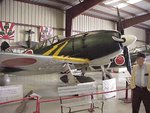R Leonard
Staff Sergeant
Numbers don't lie. By the end of the Battle of Midway, the F4F pilots already had an upper hand against the A6M2 drivers, this without the wide spread adoption of any special defensive tactics such as Jimmy Thach's Beam Defense, later known as the Thach Weave.
Personally knowing many of the fighter pilots involved in the actions at Coral Sea and Midway (for example, when I think of Jimmy Thach, I don't see some picture in a book, I remember a tall thin man sitting in our living room who was kind to children with lots of questions) I take some exception to the characterization of their physical reaction to the concept of combat with the A6M2. So I'll re-ask the question as to the source of that particular tidbit, or expect, at the least some modification of the characterization or, better, a retraction.
Regards,
Rich
Personally knowing many of the fighter pilots involved in the actions at Coral Sea and Midway (for example, when I think of Jimmy Thach, I don't see some picture in a book, I remember a tall thin man sitting in our living room who was kind to children with lots of questions) I take some exception to the characterization of their physical reaction to the concept of combat with the A6M2. So I'll re-ask the question as to the source of that particular tidbit, or expect, at the least some modification of the characterization or, better, a retraction.
Regards,
Rich

